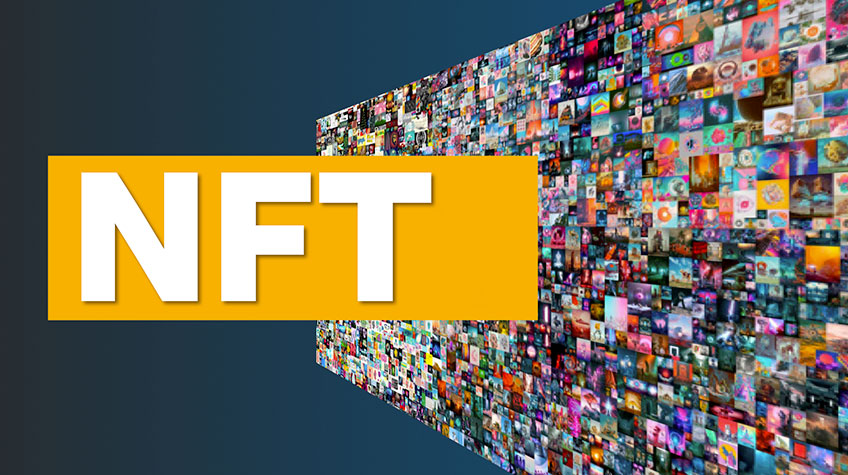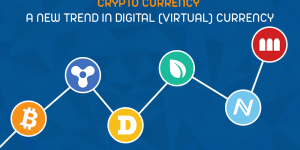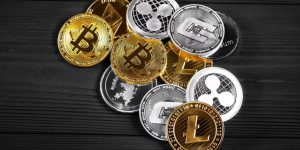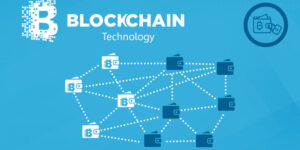
NTF or non-fungible token is one-of-a-kind and cannot be replaced by anything else.A non-fungible token is a form of cryptographic token that is one-of-a-kind in the cryptographic world.
They cannot be traded or exchanged on an equivalent basis to cryptocurrencies. It is digital work of art that exists on the blockchain network first introduced in the year 2008 with the inception of bitcoin currency which is in a variety of digital forms like:
- Images
- Tweets
- Video clips
- Memes
- Music
The fungibility of NFTs indicates that the commodity contains several units, all of which are identical, interchangeable, and indistinguishable from one another.
Neither the concept of digital representations of physical goods nor the application of unique identification is new.
When these notions are paired with the benefits of a tamper-proof blockchain-powered by smart contracts, they create a powerful force for change.
So, if you’re keen to know more about Non-Fungible Tokens, then scroll down to read the full article. This article has everything you need to know about NFTs.
So, let’s begin with the history of NFTs. Here we go…
A brief history of how NFTs evolved
In today’s world, technology is evolving at a breakneck pace, and the way individuals go about their daily lives is markedly different from previous generations.
Here is a brief history of how nonferrous metals (NFTs) came into existence.
It was initially created in the year 2012 when creators were given additional opportunities to monetize their work by providing more convenient ways to purchase and sell their things online.
Meni Rosenfeld introduced the notion of coloured coins on December 4th, 2012, and the first coloured coins were issued on the bitcoin blockchain network on December 4th, 2012.
This represented real-world assets that may be used to establish ownership of assets in the future.
The coloured coins looked and behaved exactly like conventional bitcoins, but they had a mark on them that could be used to track their usage.
Kevin McCoy, a digital artist, created the Quantum NFT on May 3rd, 2014, and between 2014 and 2016, there were significant developments and experiments that took place on Bitcoin 2.0, which led to the creation of digital assets and the beginning of the meme era.
In 2016, the meme era officially began.
Several years following the triumph of Rare Pepes in 2016, the launch of crypto punks was witnessed in the year 2017.
When John Watkinson and Matt Hall decided to create a generic project on Ethereum, they wanted to make sure that no two characters created were the same as each other.
Each has its own set of qualities that distinguish it from the others.
Related: Cryptocurrency, A Big Revolution. How to Prepare for it?
In the year 2017 – 2018, there was the release of crypto kittens, a blockchain-based game that allows users to adopt, breed, and trade virtual cats from the safety of their wallets.
It was first launched during the world’s largest hackathon for the Ethereum ecosystem by a firm called Axiom Zen. As it gained popularity, it attracted more participants, resulting in NFTs becoming more widely known.
The introduction of NFT gaming Fin took place between 2018 and 2020, and ally NFTs got public between 2017 and 2021, respectively.
► Here are different types of Non-Fungible tokens:
1. Gaming tokens
Gaming tokens are one of the recent tokens which is gaining much popularity in the recent world. It is focused mainly on in-game items. Some of the popular gaming tokens include Axie Infinity (AXS) Enjin Coin (ENJ).
2. The Real-world assets tokens
The progress in the NFT domain makes the real-world assets work as digital assets though it may look impossible. Examples of real-world assets tokens include Gold, crude oil, real estate, equity.
3. Identity Tokens
Identity tokens, as the name implies can be used as unique identifiers in the context of identity. These tokens can aid in the development of identity management systems.
For objects such as certificates and licenses that are extremely critical and require security, such tokens are required to ensure the data’s confidentiality and integrity.
This eliminates the possibility of certifications being lost in any way, whether physically or digitally.
4. The Collectibles
NFTs arose as a result of the creation of cryptocurrencies, which are virtual collectables that can be traded online.
These were the very first occasions in which individuals employed NFTs, and it has remained more popular and advantageous than any other technology in space since then.
It gained such widespread popularity in 2017 that it caused congestion on the Ethereum network.
5. Artwork Tokens
Programmable art is one of the most diverse fields of art, constantly incorporating a unique blend of creativity and technology.
Artists make graphics and use oracles and smart contracts to represent them on blockchain networks. Codes and stickers are scanned using a combination of Blockchain and IoT to ensure asset validity.
6. Media and Music Tokens
Making music links is really straightforward, allowing artists to mint their songs as NFTs more easily.
Moreover, it is helpful to both the artist as well as the followers because when artists directly communicate with their existing and potential new audiences, the listeners benefit from a more personalized experience.
NFTs can include songs, albums, music, lyrics, and soundbites, among other things. Kings of Leon was the first band to release an album as an NFT.
Music can also be blended with digital art in jpeg or gif formats to produce one-of-a-kind artwork that includes musical elements.
The concerns about music piracy have been addressed since NFTs provide a dependable means of addressing such concerns.
7. Event Tickets
These are the kind of tokens that allows people to attend events such as music festivals and concerts to verify their identity.
This is done by creators minting certain tickets in the Blockchain of a particular platform, then customers purchase the tickets through auctioning and then store them in their wallets.
This is easily done with the help of customers’ mobile phones.
► How to create your non-fungible tokens?
Minting is the process of creating an NFT in which brands of various types, such as musicians, gamers, and artists, can make and sell NFTs.
They can then list their products on their preferred digital marketplace.
The creator is compensated when someone acquires the token since they often charge a commission on their work, just as they would with any other stock.
Once uploaded, NFTs can be viewed by anybody and purchased or sold. As with any technology, NFTs have a number of advantages and limitations.
Pro Tip: If you are in a position to construct your own NFT, it is suggested to start with Binance, which is an excellent place to start.
It creates an NFT in a sequence of steps. To begin, one should acquire artwork, such as a digital painting, a piece of music or poetry, or even a film that may be represented digitally.
Second, after selecting your artwork, obtain some Ether (the Ethereum-based cryptocurrency) for simplicity’s sake.
It is the most widely used and renowned network in non-financial trading markets. Meta mask is one of the simplest forms of Ether to utilize, as minting an NFT may be somewhat costly.
Following that, you select a marketplace where you will construct and then list your NFT. The most prevalent types are minable, open sea, and variable.
Utilize any of the three, particularly the free Open Sea.
Finally, once you’ve connected your ETH wallet to your marketplace, you can create your NFT.
Also Read: 10 Best NFT Marketplaces to Buy and Sell NFT
► Characteristics of Non-Fungible Tokens
Non-fungible tokens possess the following characteristics:
1. They are Unique:
Each non-fungible token has a unique piece of information that differentiates it from the others.
A work of digital art may include coded information on individual pixels, whereas tokenized in-game things may include information that enables the client to determine which item the player owns and its attributes.
2. They are Traceable:
Each NFT, including all of its attributes, has a record of transactions on-chain, which means that each of the tokens can be verified as real, which is a critical feature for both buyers and sellers.
Even if a token is compromised, its ability to identify its origins makes it relatively straightforward to resolve and maintain.
3. They are Rare:
They are scarce on the market. This increases their worth in the eyes of clients, allowing them to become and remain coveted for an extended period of time.
4. They are Indivisible:
NFTs mostly cannot be transacted as small units. It is traded as a whole.
5. They possess Programmability Feature:
Since they are completely programmable, they have great functionality.
► Advantages of NFTs
Here are some of the advantages of Non-Fungible Tokens, which make them unique:
1. NFTs Contribute to Market Efficiency
The most evident advantage of NFTs is that they have the potential to increase market efficiency.
Converting a physical asset to a digital one simplifies operations, eliminates intermediaries, improves supply chains, and increases security.
Additionally, digitizing artwork enhances the authentication process, expediting transactions and lowering expenses. However, NFTs have applications outside of marketplaces.
They may eventually turn into a viable method for individuals and businesses to manage and regulate sensitive data and records.
For example, Physical passports, which is produced at each point of entry and exit. The process can be streamlined by converting them to separate NFTs.
This will save a significant amount of time and money in turn.
2. NFTs Can Be Used to Fractionalize Physical Asset Ownership
Today, fractional ownership of some assets, such as real estate, artwork, and expensive jewellery, is impossible.
It is significantly easier to divide a digitized version of a building amongst numerous owners than it is to separate a physical one.
Likewise, a priceless piece of jewellery or a limited-edition bottle of wine fall into this category.
The market for certain assets can be significantly extended by digitalization, resulting in increased liquidity and higher prices.
Individually, it has the potential to alter the way financial portfolios are constructed by allowing for greater diversity and more precise position sizing.
3. NFTs are Secure
NFTs are made utilizing blockchain technology, a method of storing data that is impenetrable to hacking, altering, or deleting.
In a layman’s term, a blockchain is a digital log of transactions that is replicated and distributed throughout an entire peer-to-peer network of participants.
All NFTs on the blockchain have unique authentication and ownership records, which may prevent them from being misused or stolen.
After adding data to the chain, it cannot be edited or deleted. This preserves each NFT’s rarity and validity, fostering a level of confidence uncommon in many markets.
4. NFTs Can Help Diversify an Investment Portfolio
Traditional investments, such as shares and bonds, are different from conventional investments. They possess unique characteristics and provide benefits.
Even the risk profile of NFTs is different from that of other asset classes. As a result, by having NFTs in an investment portfolio, you can increase portfolio efficiency.
Essentially, this means achieving a more favourable risk-reward ratio.
5. NFTs Assure the Inclusion of all Individuals
All content providers in NFTs are brought together into a single ecosystem, which opens up new opportunities for team growth.
This enables them to collaborate and increase their productivity. Additionally, creators interact with their clients and derive value from their works.
Additionally, buyers have the option of liquidating their various assets.
6. NFTs Help Create Economic Opportunities
Due to the breadth of its applicability in the realm of digital content in the modern world, it has increased the economy, which will focus on assisting content creators in avoiding the need to transfer ownership to the platforms they use to promote their work.
When a creator sells their work, ownership of the work is transferred to the work itself.
7. NFTs Ensure Content Transferability
It enables convenient trading on specific markets with a diverse choice of trading possibilities. Assists in resolving the issue of walled gardens in games, and many gamers purchase them to enhance their gaming experience.
They can also use the in-game things outside of the game and even profit from them.
Since NFTs are based on contracts, ownership transfers occur more quickly and can be completed when the seller and buyer meet particular conditions.
Non-fungible tokens are typically purchased and sold on a variety of different markets, and their utility is determined by their uniqueness.
Downsides of NFTs
Every coin has two sides; similarly, Non-Fungible Tokens also have some downsides, which are as follows:
1. It is impossible to digitize physical art. Given that NFTs operate in the form of digital data, they cannot be used effectively in most physical applications because physical art cannot be digitized.
The actual presence of art attracts clients more than the digital presence of the same art.
2. NFTs are highly risky and uncertain. Due to sites like WhatsApp and Facebook, people may easily locate copies of your work that you hold tokens on the internet and copy copy-paste files in this media, sharing something you have spent lots of money and time on.
3. NFTs are really pricey. Due to the technology which is involved, NFTs become so expensive.
► Reasons as to why should you buy a Non Fungible Token?
Investment in non-fungible tokens has been the most lucrative in recent times. It’s profitable for a number of reasons, including the following:
You can tokenize them. Physical assets like artwork can be tokenized in order to prevent their duplication and limit the number of people who can own them.
This is a property that the token ensures because of its inherent value. As a result of this, work becomes scarcer and therefore more valuable.
You can convert them into cash anytime. The ability to rapidly convert an asset into available cash when there is a need without hurting the asset’s market value is known as asset liquidity.
When an investor wishes to spend cash, they can quickly and easily obtain it through the usage of tokenized assets.
Non-fungible tokens have a lot of room for growth because the world is changing rapidly, and tokens are one of the ways that individuals may trade.
For example, owning and even controlling virtual lands gives one the power to decide what to do in the land where one can
- Rent it out
- Build up a solid structure
- Secure business for advertising or even online sales
Consider investing in non-fungible tokens because it is more advantageous and recent.
► The Bottom line
Non-fungible tokens are one of the hottest topics in online commerce right now. It has developed into a compelling selling point for a variety of users.
Hopefully, this article has been informative for you and help you understand NFTs in detail.
So, follow the advice in the preceding section on understanding NFTs to discover innovative methods to utilize the benefits of NFTs to achieve the greatest possible results






